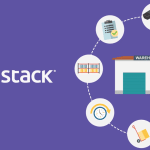
When selecting, designing, staffing, and optimizing your ecommerce warehouse, you must consider your inventory and how you plan to move it. A big part of that planning involves identifying your heavy equipment needs. Lifting and moving palletized inventory is a constant occurrence in any retail warehouse.
While palletizing is ideal for storing and shipping bulk inventory, moving and lifting palletized inventory requires specialized equipment. This is where forklifts and pallet jacks come in. There are notable differences between these two types of heavy warehouse equipment.
Making the correct choice for your business can lead to notable gains over the life of the equipment in terms of workflow efficiency, warehouse productivity, and inventory handling costs.
Forklifts
Forklifts are industrial vehicles with a powered front end designed to lift and lower cargo. The namesake forks are spaced to fit evenly into the open ends of standard pallets, making it easy to lift and move palletized inventory.
Forklifts come in many varieties, each suited to different use cases. Some of the most significant distinctions to pay attention to when assessing forklift purchase include:
Forklift Motors
Forklifts are available with either combustion or electric motors. Combustion-powered forklifts are typically best suited for outdoor use (like in an open-air stock yard or on a loading dock) due to their fuel emissions and noise level.
Electric-powered forklifts do not produce engine emissions and are available for both indoor and outdoor use. Electric motors are also substantially quieter than combustion motors. That said, regular maintenance is required for forklift motors regardless of how they are powered.
Forklift Size
Some forklifts have taller masts (the front portion of the forklift that raises and lowers loads) than others. Likewise, the counterweight attached to the rear of a forklift will vary in proportion to the height of the mast and the vehicle’s maximum load rating. The heavier and taller the forklift, the higher energy usage you can anticipate.
Forklift Operator Position
Some forklifts are optimized for narrow spaces and require the operator to stand upright while driving them. Others are configured with seats for operators to drive like a more standard vehicle.
Forklift Functions
Forklift technology is constantly improving and evolving. Modern advancements include cameras and lasers to ensure accurate inventory handling and placement, and touch-screen technology to provide operators with granular control over forklift loads.
Specific forklifts are also optimized for moving unique items such as rolled products, furniture, and even entire shipping containers.
Pallet Jacks
Pallet jacks are similar to forklifts in that they have a pair of forks designed to fit into and lift palletized stock. Rather than being driven, pallet jacks are typically pulled or pushed on their wheels via a large handle. Like forklifts, pallet jacks come in several different models. Each model offers distinct differences in form and function.
The main differences fall into the following categories:
Manual or Motorized Pallet Jacks
The most affordable and basic pallet jacks utilize manual pump handles to raise loads and pull them. More advanced pallet jacks use electric motors to reduce or eliminate workers’ required exertion.
Pallet Jack Size
Pallet jacks are available in wide and narrow configurations to suit specific use cases.
‘Walkie’ or Rider Pallet Jacks
Motorized pallet jacks are designed so that the operator must either walk behind the equipment or ride it. Rider position can vary by model, but the operator almost always handles the equipment from a standing position.
Pallet Jacks with or without Masts
Some pallet jacks have forklift-style masts, which allow loads to be lifted and stacked rather than simply lifted enough to move. Masted pallet jacks are commonly referred to as ‘stackers.’
Frequently Asked Questions When Deciding Between Forklifts and Pallet Jacks
When it comes to loading and unloading trucks, shelving and retrieving palletized inventory, or simply moving heavy items throughout the warehouse, both forklifts and pallet jacks are indispensable tools.
The key is to determine which combination of forklifts and pallet jacks makes the most sense for your warehouse and staff. Each piece of heavy equipment represents a sizable investment, so you want to make the right choices.
Failure to do so could not only impede your warehouse team’s ability to manage inventory and fulfill orders effectively but also lead to costly consequences.
What Are the Primary Differences between a Forklift and a Pallet Jack?
Below are some of the most critical differentiators to evaluate when choosing forklifts and pallet jacks for your warehouse.
| Forklifts | Pallet Jacks | |
| Initial Cost | More expensive (approx. $20,000-$50,000)* | Less expensive (approx. $300-$3,000)* |
| Maintenance | More frequent and costly maintenance is required | Less frequent and costly maintenance is required. |
| Size | Taller, typically larger. | Shorter, typically smaller size. |
| Maximum Load Weight Range | 3,000-50,000+ lbs.* | 1,500-5,000+ lbs.* |
| Maximum Lift Height | 8-30+ ft.* | 1-8 ft.* |
| Maneuverability | Easier to maneuver. | It can be challenging to steer through tight aisles and around tight turns. |
| Operator Efficiency | Less labor-intensive operation. | More physical exertion is required. |
| Operational Speed | Can transport and lift more quickly. | Slower operational speeds. |
Are Forklifts or Pallet Jacks More Cost-Effective for Your Warehouse?
Considering all the aforementioned differentiating factors together can help you determine the ideal heavy equipment purchases for your warehouse. That said, as with most decisions that come with running an ecommerce business, one of the leading considerations is likely cost.
When deciding between forklifts and pallet jacks, your cost-benefit analysis needs to include three key factors:
- Pallet quantity. How many pallets must you move in a day, month, or year? Consider loading and unloading shipments and fulfillment movements (such as preparing and moving bulk shipments for FBA or WFS restocking).
- Pallet-related labor costs. How much time is spent moving palletized and/or oversized inventory into, throughout, and out of your warehouse?
- Heavy machinery costs. Consider the total annual fuelling and maintenance costs for the equipment you are considering. Also, divide the purchasing/financing costs of equipment by its life expectancy as part of this calculation.
With these data points and estimates, you should be able to identify the best value-based options for your warehouse needs. While forklifts may be more expensive to purchase and maintain, they likely result in lower labor costs and increased efficiency.
Conversely, pallet jacks may provide similar benefits to forklifts in specific use cases at substantially lower costs. It stands to reason that the person or team responsible for choosing between forklifts and pallet jacks (or a combination thereof) must intimately understand your warehouse’s needs, budget, and workflows.
Thankfully, these big-ticket decisions don’t need to be made based on gut instinct alone.
Combining a powerful WMS (Warehouse Management System) like Skustack and a comprehensive warehouse visualization tool like Skustack Lens can make it simple to assess the efficiency and work rate of both your heavy equipment and the associates using it.
As a result, you can make these types of equipment purchasing decisions driven by your business’s data and specific warehouse workflows.
What Training and Certifications Do Workers Need to Use Forklifts or Pallet Jacks?
From OSHA’s perspective, forklifts and pallet jacks are simply two different versions of the same tool: a ‘powered industrial truck.’
As such, both forklifts and pallet jacks are subject to the same training and certification requirements. Of particular note is that all operators must be at least 18 or older. Thankfully, training is not incredibly expensive or time-consuming.
There are many OSHA-approved training courses available online, many of which offer discounts to employers wishing to train multiple staff members. Some even offer courses to train your in-house trainers to help ease the onboarding of future hires.
What are the Storage Considerations for Forklifts and Pallet Jacks?
First and foremost, you need to consider where your heavy equipment will be stored. These are considerations that must come into play when making purchasing decisions as well as when designing your optimal warehouse layout.
To get the optimal longevity out of your forklifts and/or pallet jacks, they must be stored in dry, flat locations with masts and forks lowered to the ground. Most equipment also has parking brakes and other safety features to ensure that machines can be securely stopped and present minimal tipping risk. Ultimately, you need to have space in your warehouse to accommodate these storage needs.
Power is another consideration when storing forklifts and pallet jacks. Electric equipment will need sufficient access to receptacles to charge when not in use. Similarly, combustion engine forklifts would likely benefit from being stored near refueling stations.
Additional steps should be taken to protect an investment when storing a forklift or pallet jack for long periods. Lubricate relevant components to prevent dry rot. Ensure batteries are disconnected (to prevent drain or possible electrical issues) and fuel tanks are drained. Release any remaining pressure stored in hydraulic components.
While equipment is being stored for longer stretches, regular checks on tire pressure and engine function can ensure that your heavy equipment is ready to go when needed.
Upgrading Your Warehouse Efficiency and Profitability Is All About Making the Right Choices
Running your ecommerce warehouse can simultaneously improve both your omnichannel business workflows and bottom line. Just as it is important to make the right decisions about big-ticket purchases like forklifts and pallet jacks, it is also crucial to have the right tools to organize, manage, and monitor all the different moving parts of your warehouse operations.
Skustack, Descartes Sellercloud’s warehouse management platform, is built on patented technology that provides access to industry-leading WMS features. Using our fully integrated platform, you can ensure that your warehouses deliver maximum benefits and profitability.
Contact us directly for a free demo of Skustack to see why choosing the ideal WMS for your omnichannel ecommerce business doesn’t have to be a difficult one.




